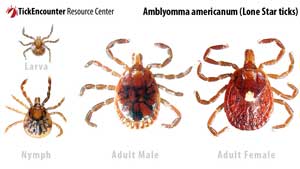Although the Lone Star tick (Amblyomma americanum) doesn’t transmit Lyme disease, it brings several new threats to the tick scene in the Northeast. It is most commonly believed that climate change, which is having a major impact on tick populations in general, is the main cause of their spread.
The Lone Star tick is named for the white spot on the back abdomen of females, along with its previous home in and near Texas. What this tick is most well-known for is its inclination to aggressively pursue a bloodmeal.
“Questing,” or passively waiting with legs outstretched for an unwitting passerby to brush up against them, is the method of choice for other species of ticks. By contrast, the Lone Star tick actually chases down its victim, and according to the U.S. Centers for Disease Control and Prevention (CDC), is known to move long distances in pursuit of the host. Adding to that is the fact that the Lone Star is the only American tick that will bite in its larval form as well as adult.
Health threats are significant from this tick, and include an illness called the Heartland virus, as well as the bacterial infection human monocytotropic ehrlichiosis. Heartland virus, discovered in northwestern Missouri by Dr. Scott Folk of Mosaic Life Care in St. Joseph, Mo., has a total of eight reported cases by the CDC, with one fatal.
There is no cure for Heartland virus, and early intervention and management of symptoms is the only treatment at this time. Human monocytotropic ehrlichiosis is far more widespread and serious; symptoms can range from almost none to toxic shock-like. Unlike Heartland virus, testing can detect human monocytotropic ehrlichiosis and it responds to antibiotics, similarly to Lyme disease.
An allergy to red meat is yet another phenomenon associated with the Lone Star tick. Once bitten, the human host can develop an allergy to meat and meat products (as well as cat dander), which can cause a serious skin rash and even potentially life-threatening anaphylactic symptoms. Once diagnosed, they are certainly at the least life-changing. Allergic symptoms can occur even with cross contamination, with at least one report of an incident of a reaction from a customer eating in a vegan restaurant.
It is becoming increasingly clear that climate change is playing heavily into the spread of the Lone Star tick and the overall increase in tick populations. State Sen. Jim Dill (D-ME) is a pest management specialist for the University of Maine Cooperative Extension. He says he believes heavy snow has insulated ticks in winter that would normally freeze and die, and warmer temperatures and heavier rains in the summer have allowed them to thrive.
Dill says, “They were fat and happy all winter long, and we’re seeing a lot of ticks in the spring.”
In addition, a team of scientists led by Dr. Taal Levi of Oregon State University and Dr. Richard Ostfeld of the Cary Institute of Ecosystem Studies analyzed 19 years of data on black-legged ticks in the Northeast.
“The bottom line is that as the climate warms, it is pushing the timing of tick nymphs and larvae forward, potentially changing the interactions they have with their hosts,” says Levi, an assistant professor in OSU’s Department of Fisheries and Wildlife in the College of Agricultural Sciences and lead author on the study.
As our climate changes, so does our world. The clear and present danger of growing tick populations and tick-borne diseases puts public awareness and pest control on the front lines of this very real threat.

Leave A Comment